Traditional agroforestry parkland systems in Burkina Faso are under threat due to human pressure and climate variability and change, requiring a better understanding for planning of adaptation. Field experiments were conducted in three climatic zones to assess Sorghum bicolor (L.) Moench (Sorghum) biomass, grain yield and harvest index in parklands under different rainfall pattern and compared to simulations of sorghum biomass and grain yield with the Water, Nutrient and Light Capture in Agroforestry Systems (WaNuLCAS) model for calibration and parametrisation. For planning adaptation, the model was then used to evaluate the effects of different management options under current and future climates on sorghum biomass and grain yield. Management options studied included tree densities, tree leaf pruning, mulching and changes in tree root patterns affecting hydraulic redistribution. The results revealed that sorghum biomass and grain yield was more negatively affected by Parkia biglobosa (Jacq.) Benth. (néré) compared to Vitellaria paradoxa C. F Gaertn (karité) and Adansonia digitata L. (baobab), the three main tree species of the agroforestry parkland system. Sorghum biomass and grain yield in different influence zones (sub-canopy, outside edge of canopy, open field) was affected by the amount of precipitation but also by tree canopy density, the latter depending itself on the ecological zone. The harvest index (grain as part of total biomass) was highest under the tree canopy and in the zone furthest from the tree, an effect that according to the model reflects relative absence of stress factors in the later part of the growing season. While simulating the effects of different management options under current and future climates still requires further empirical corroboration and model improvement, the options of tree canopy pruning to reduce shading while maintaining tree root functions probably is key to parkland adaptation to a changing climate.
DOI:
https://doi.org/10.1007/s10457-013-9651-8
Altmetric score:
Dimensions Citation Count:
























